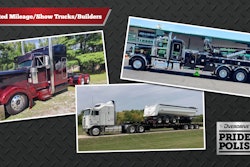A technician remounts a clutch – typical of what would happen when overhauling a clutch or transmission, or even when installing a new or remanufactured engine as the transmission is reassembled to the engine.
The cylinder blocks and heads of a Class 8 diesel engine will practically last forever if properly maintained. Their design allows all the wear surfaces – such as cylinder liners, bearings, valve guides and seats – to be removed and replaced, so the block and head themselves normally won’t experience any wear. That’s why your engine has replaceable cylinder liners.
Transmission cases and differential carriers are designed on similar principles, allowing complete disassembly and replacement of all working parts.
As a result, major truck components can be overhauled to new specs for much less expense than buying a new engine. An entire rebuilding industry has sprung up with four different approaches to restoration:
- An in-frame overhaul where the block remains in the chassis and one or more cylinder heads are re-installed. New or reconditioned parts are installed, but no machining is done. This normally is done when a vehicle has begun to consume oil but has not accumulated high miles. The cylinder liners, piston rings, pistons, connecting rod and main bearings are replaced, along with the gaskets. The cylinder heads remain untouched because wear there normally has less effect on oil consumption.
- An in-frame overhaul where the block remains in the chassis, and all in-block wear parts are replaced, and the cylinder head is replaced by a remanufactured design. Reman means exactly that: As with the original manufacture, the work is done on a production line by highly trained factory workers using sophisticated tools, cleaning and inspection techniques.
Cylinder heads are more likely to be remanufactured because machining and other specialized precision work are necessary for valves to seat and seal properly. The well-equipped shop at Penn Detroit Diesel Allison in Fleetwood, Pa., can properly restore a Series 60 head, but it’s cheaper to get a reman from Detroit Diesel, says Barry Spitler, service manager.
- An out-of frame overhaul requiring the removal of the cylinder block from the engine compartment. This is done for various reasons: to “align bore,” or restore the alignment of the crankshaft bearing surfaces because they have warped slightly over the miles; to similarly machine the top deck of the block to flatten it; or even to repair minor cylinder block damage. In this situation, Cummins suggests using its ReCon reman blocks.
- A remanufactured engine. The engine is completely disassembled. All parts are first inspected – using sophisticated techniques that may not be available locally – and then renewed or restored on a production line. One advantage of a reman engine is that all the auxiliaries that may affect its life and performance, such as the turbo, injectors and water pump, are replaced as part of the process.
EMISSIONS REQUIREMENTS
Under most circumstances, when an engine is overhauled, its emissions system must be restored to its original condition so the engine will meet the emissions standard that applied when it was built. There are exceptions, however.
“Engines built between 1994 and 1998 that have over 290,000 miles on them will need to adhere to the Low NOx Rebuild Program,” a U.S. Environmental Protection Agency standard, says Andrew DeWitt, product development manager at Detroit Diesel.

This may mean slightly different injection system parts and a reprogrammed engine control module to change the injection parameters. Your rebuilder will need to order the right parts from the engine manufacturer or a high-quality aftermarket parts supplier.
IN-FRAME VS. REMANUFACTURED
A number of factors need to be considered in deciding which approach to take, in-frame or remanufactured. But one fact is clear: One of the biggest reasons to maintain your engine is what happens when you try to overhaul it. It’s similar to maintaining a tire casing so you can retread it and not have to pay for a new or exchange casing.
Lancaster Peterbilt in Lancaster, Pa., frequently does in-frame overhauls on Caterpillar C15 engines and its earlier brother, the 3406E. “You need a good base for an in-frame overhaul,” says Dave Brown, shop foreman. “But if there are no issues with the cylinder block and heads, it will last as long as a remanufactured engine.” In his shop, an in-frame costs about $18,000, while a reman engine costs about $22,500, he says.
Painstaking maintenance is essential. Minimizing corrosion and scale in the cooling system will keep the block and head from overheating and warping, which will save you the need for machining or a crack repair. Oil and filter changes will prevent failure of a bearing, piston ring or other internal part that could break loose and cause serious structural damage.
In general, when you’ve managed to keep your engine castings in tip-top shape, a high-quality in-frame overhaul probably is the best overall value per dollar and the correct thing to do. Unless the engine is at low miles because the pistons, rings, liners and crankshaft bearings have prematurely worn, a remanufactured head would be included, so you’d be unlikely to experience a rocker or valve-related failure during the life of the parts you’ve renewed. Since the truck normally would be at high miles at this point anyway, chances are you won’t need a remanufactured engine assembly just to carry you to trade-in.
There are other considerations, however, when looking at a reman engine. One is whether the available warranty is better than the warranty you would get with the best overhaul and, if it is, whether you want that security. If the truck still is relatively new (say, under 600,000 miles), a reman may be right, especially when it gets you a desired increase in warranty. A special case is when you feel the truck is a classic, and you are dedicated to continually restoring the body and other parts to keep it.
Also consider the condition of engine auxiliaries such as injectors, water pump and geartrain. If you want or need all these parts replaced because they are as old as the engine, a reman may be more cost-effective.
The decision always depends on the condition of the vehicle and its potential for continued use. Spitler’s Detroit Diesel shop uses a ladder of miles to determine the minimum conditions that justify various overhauls or a reman. But whatever the criteria, “You can’t spend $15,000 to put a remanufactured engine in a $15,000 truck,” Spitler says.
THE RIGHT IN-FRAME
Lots of people do overhauls, but not all of them can guarantee the parts will be like new. Engine makers’ overhaul programs certify technicians, guarantee the parts and provide solid warranties.
CATERPILLAR: Overhaul Protection for Trucks requires all critical components to be inspected and major ones replaced. It includes four warranty options with maximum coverage at 36 months or 300,000 miles. Each Cat Reman engine is dynamometer-tested to meet the same specifications as a new engine, says Mike Powers, product development manager: “This type of remanufacturing with built-in quality checks and controls simply cannot be duplicated in a repair shop environment.”
CUMMINS: “An overhaul is typically the replacement of cylinder kits, bearings and gasket sets,” says Tish Fuller, director of parts marketing. “A cylinder head may also be used as a deeper rebuild is required.” Cummins ReCon reman parts, including heads, carry warranties, Fuller says. More extensive rebuilds come with the National Overhaul Warranty, which includes the entire engine, including labor and progressive damage. “Extended coverage options for these engines may also be purchased through the local Cummins distributor,” she says.
DETROIT DIESEL: Its StepUP program offers four levels of service, says Andrew DeWitt, product development manager. Step 1 includes all in-block parts, camshaft bearings and head bolts, plus other essentials such as gaskets and thermostats. Step 2 adds a reliabilt-brand reman cylinder head assembly and rocker arm kit. Step 3 adds a reliabilt turbo water pump and injectors. Step 4 is a replacement engine “restored to like-new power and performance,” with dynamometer tests and possible horsepower and displacement upgrades, DeWitt says. All reman parts come with a one-year warranty, twice as long as the new-part warranty.
MACK: A remanufacturing center in Middletown, Pa., refurnishes and sells used parts. This includes complete engine assemblies.
VOLVO: Reman components from Volvo are remanufactured to exact OEM/Service specs, according to the company’s website. These items are manufactured under theVolvo Quality System, which is registered to the ISO 9001-2000 industrial standard.
Whichever method you choose, be sure to match the rebuild’s life expectancy to the life expectancy of the truck. Get the overhaul or reman you need to reach trade-in, together with enough warranty to protect you from the disaster of an unexpected engine repair.
Transmissions and axles
Should you overhaul a major truck component such as a transmission or axle, or purchase and install a remanufactured unit as a complete, ready-to-go system?
“Downtime will typically be less and the warranty will likely be better with a new reman unit when compared to rebuilding the customer’s transmission,” says Eugene Clark, Eaton and Roadranger product manager for aftermarket transmissions. “Conversely, the cost could be higher. In either case, there should be no difference in the quality, and both should provide reliable service for the same amount of time – provided, of course, you are dealing with a first-class supplier and one that employs genuine, OEM-quality parts.”
Those same suppliers will be able to deliver reman units or parts within 48 hours, Clark says. “Some dealers may even have the parts inventoried. So it comes down to what type of investment you want to make and how much time you have to complete the project.”
“Because these are commercial vehicles and downtime costs money, speed is usually the determining factor for repair,” says Sandy Landgren, drivetrain product manager for ArvinMeritor’s commercial vehicle aftermarket unit. “Normally, drive axle differential carriers and transmissions for commercial vehicles do not go through a disassembly, inspection and component replacement process with the same unit going back to the customer. Most units are exchanged with a pre-built unit usually in stock in the local market or readily available in a day or two.”
Internal gear adjustments are crucial, says Rick Martin, manager of training and technical publications at ArvinMeritor. “A remanufacturing facility has the expertise and tooling to perform these adjustments per the manufacturers’ recommendations in an accurate and consistent manner.”
Various grades of transmissions and axles are available, ranging from new to OEM reman to locally rebuilt, Landgren says – but you’re smart to get a component that offers a nationwide warranty. Moreover, factory remans often employ state-of-the-art design that wasn’t available when the part first came off the line, Landgren says.
Balance the parts’ quality, warranty and service with the age of the truck and the years left to it.









